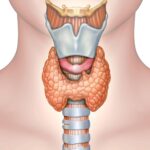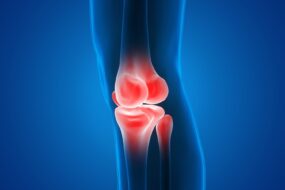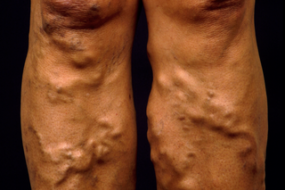Acromegaly is a clinical syndrome caused by excessive secretion of growth hormone. A somatotroph adenoma of the anterior pituitary is the most common cause. Growth hormone excess that occurs before fusion of the growth plates is called pituitary gigantism.
The two conditions may be combined if hypersecretion starts in adolescence and continues to adulthood.
Clinical presentation
- Attributable to high growth hormone(GH) and insulin-like growth factor 1( IGF-1)
- Onset is insidious, with slow progression.
- The most common complaints are headaches and sweating
- Direct effects of the pituitary tumor – headache, vision loss, symptoms related to decreased secretion of other pituitary hormones, mostly gonadotropins
Effects of high GH/IGF-1
- Soft tissue overgrowth and skin thickening
- Hypertrophic arthropathy of knees, ankles, hips, spine, and other joints
- Enlargement of visceral organs- thyroid, heart, liver, lungs, and kidneys. Reversible prostate enlargement may occur.
- Cardiovascular disease- hypertension, cardiomyopathy, left ventricular hypertrophy.
- Sleep apnea
- Hyperinsulinism, insulin resistance, overt diabetes
- Increased risk of colonic neoplasms, colonic diverticula,
- Increased risk of other tumors, e.g., stomach, esophagus, melanoma
*Twofold increased mortality if untreated
Investigations
1. Oral glucose tolerance test- measure the growth hormone
- GH is suppressed in normal subjects to below 0.5 mcg/l. In acromegaly, GH is not suppressed, and in about 30% of cases, there is a paradoxical rise
2. Serum IGF-1 levels- elevated.
3. Do pituitary function investigations. There is hyperprolactinemia in 30% of cases
4. Additional- colonoscopy for neoplasms, cardiac tests, liver function tests, thyroid function tests
Management
Goals;
- Improve symptoms
- Normalise serum GH and IGF-1
- Reduce morbidity and mortality
1. Surgical- transsphenoidal surgery is the recommended first line of treatment, especially for those with microadenomas.
- Debulking for macroadenomas
- Post-operative imaging and OGTT results guide further management
2. Radiotherapy
- 2nd line of therapy if acromegaly persists after surgery.
- GH levels fall slowly, however, and there is a risk of hypopituitarism
3. Medical
-If acromegaly persists after surgery, to lower GH levels to below 1mcg/L and normalize IGF-1 levels
-Somatostatin analogs are administered as slow-release injections every few weeks.
- They can also be used as primary therapy.
-Dopamine agonists- especially with associated hyperprolactinemia
-Pegvisomant- a GH receptor antagonist. Those for whom somatostatin analogs do not sufficiently lower GH and IGF-1 levels.












